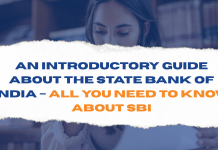The History of modern banking in India started in 1770 when the first Joint Stock Bank named as Bank of Hindustan was established by Alexander and Co. in Calcutta. This bank was, however terminated in 1832. The history of Indian banking has been classified into two phases i.e. Pre Independence and Post-Independence. Let’s talk about each in detail.
Pre-Independence Phase:
This phase is known to be have largest number of banks in Indian banking i.e. 600 banks. The real growth of Indian banking began when India’s first presidency Bank (Bank of Bengal) was established in 1806 in Calcutta. It followed the establishment of other two presidency banks i.e. Bank of Bombay (est. 1840) and Bank of Madras (est. 1843). These three banks continued till 1920 before they consolidated into one i.e. Imperial Bank of India.
About Imperial Bank of India:
Imperial Bank of India which is now known as the State Bank of India is one of the prominent banks of India. It was renamed as State Bank of India in 1955. The State Bank of India was given control to eight state associated banks in 1960 under the State Bank of India Subsidiary Act, 1959. On February 15, 2017, the Union Cabinet approved the merger five associate banks with the SBI, the merger came into effect on April 01, 2017.
There were many banks that came in this phase but failed to survive. For example. General bank of India (1786-1791) and the first commercial bank of India i.e. Oudh Commercial Bank (1881-1958). However many banks who were established then and still continuing to lead today are:
Allahabad Bank:
It was established in 1865. Allahabad bank is the oldest Public Sector Bank in India having its branches all over India.
Punjab National Bank:
Punjab national bank was founded by Lala Lajpat Rai on May 19, 1894 in Lahore, Pakistan. The common objective was to create a truly National Bank that would work for the economic interest of the country. PNB enjoys the position of being the first Indian bank that have been started solely by Indians on the Indian Capital that survived till now. Note: the first entirely Indian bank was Oudh Commercial bank established in 1881 in Faisalabad but was ceased to operate in 1958. PNB holds the privilege of maintaining accounts of some of our profound national leaders of that time. For example: Mahatma Gandhi, Lal Bahadur Shastri, Jawahar Lal Nehru Indira Gandhi and the famous Jalianwala Bagh Committie.
Central Bank of India:
It was established on December 21, 1911. The founder of CBI was Sri Sorabji Pochkhanawala and Sri Pherozeshah Mehta. This bank claims to be the first Commercial bank of India that has been owned and Managed by Indians completely.
Bank of India:
Bank of India was founded in 1906 and got nationalized in 1969. It is headquartered in Mumbai. BOI is the first ever Indian bank that opened its branch overseas (Outside India). Its first overseas branch was opened in London in 1946, then Paris in 1974.
Bank of Baroda:
Bank of Baroda was founded on July 20, 1908 in the state of Baroda, Gujarat, by the Maharaja of Baroda, Maharaja Sayajirao Gaekwad III. BOB is an Indian state owned international banking and financial serviced company. It is also known as India’s International Bank as it has more branch overseas among Indian banks.
Reserve Bank of India (Central banking institution) which controls the monetary policy was also formed (April 01, 1935) in that time on the recommendation of Hilton Young Commission (1926).
In this phase, most of the banks experienced high rate of failures which results in low public confidence. People at that time relied on unorganized sectors for example Moneylenders and indigenous banks.
Post-Independence Phase:
This phase is often known as Nationalization era. On January 01, 1949 the Reserve Bank of India was nationalized by the GOI. Government of India found the need to nationalize the banks due to the following reasons:
- To promote sectors like Agriculture, Small Scale Industries and exports that were being neglected by the banks.
- The banks were entertaining the needs of Large scale industries and big businesses rather catering the needs of poor population.
- The Government of India found that the poor population of India was still in exploitation by the moneylenders as they didn’t have confidence in the banks.

On July 9, 1969, Government of India nationalized fourteen commercial banks. Smt. Indira Gandhi was the Prime Minister at that time. The number of banks that got nationalized were as follows:
- Punjab National Bank
- Central Bank of India
- Dena Bank
- United Commercial Bank
- Canara Bank
- Syndicate Bank
- Allahabad Bank
- Indian Overseas Bank
- Bank of Maharashtra
- Union Bank of India
- Bank of Baroda
- Bank of India
- United Bank
- Indian Bank
In April 1980, six more commercial banks were nationalized by the Government of India. Those were:
- Andhra Bank
- Corporation Bank
- New Bank Of India
- Oriental Bank Of India
- Vijaya Bank
- Punjab and Sindh Bank
Around the same time, Regional Rural banks (RRB’s) were established on October 02, 1975, on the recommendation of Narasimham Commitiee. The sole objective behind formation of RRB’s is to cater the needs of Agricultural sector and to serve the large population of rural sector.
About Narasimham Commitiee:
It was formed to analyse India’s banking sector, to make it more competitive effective and efficient by recommending legislation and regulations.
In order to promote the specific requirements of the Agricultural sector, National Bank for Agriculture and Rural Development (NABARD) was formed in 1982. Similarly, some other apex level of institutions like EXIM bank (est. 1982), NHB (est. 1988) and SIDBI (est. 1990) were formed to serve the requirements of foreign trade, housing and industry.
National Bank for Agriculture and Rural Development (NABARD):
NABARD was formed on July 12, 1982, on the recommendations of B. Sivaraman Committee. It replaced Agriculture Refinance and Development Corporation (ARDC), Agricultural Credit Department (ACD) and Rural Planning and Credit Cell (RPCC). NABAARD is counted as one of the premier agencies that provide development credit to rural areas.
Export-Import bank of India (EXIM) Bank:
Export-Import bank of India was established in 1982 under Export Import bank of India act 1981. It is the premier export finance institution of India. It has been a catalyst in the promotion of cross border investment and trade.
National Housing Bank (NHB):
National Housing Bank (NHB) was established on July 09, 1988, under the National Housing Bank Act, 1987. It is a wholly owned subsidiary of Reserve Bank of India (RBI). This apex institution was formed with an objective to promote housing finance institution at local as well as regional levels.
Small Industries Development Bank of India (SIDBI):
Small Industries Development Bank of India (SIDBI) was set up on April 02, 1990. It was initially incorporated as a wholly owned subsidiary of Industrial development bank of India. SIDBI was formed with an objective to aid the growth and development of micro small and medium-scale enterprises (MSME) in India.
Aftermath of Nationalization:
- Public confidence was boosted with the improved efficiency in the banking system.
- Sectors which were lagging behind such as Agriculture, Small and medium industries were blooming with the funds which led to the economic growth.
- Banks penetrated to the rural areas, which eventually helped the poor masses of the country.
After the nationalization of banks, many were still untouched by the banking services. Keeping this in mind, Narasimham Commitiee recommended to allow the private sector players into the banking system in 1991. RBI gave license to 10 private entities but few of them met the market needs namely, ICICI, HDFC, Axis Bank, Induslnd Bank and DCB.
Narasimham Commitiee again recommended the entry of more private players in 1998. RBI gave license to the following: Kotak Mahindra Bank (2001) and Yes Bank (2004).
In third round of licensing which took place in 2013-14, two new banks got the license i.e. IDFC Bank and Bandhan Bank in 2015.
Also Read:
Get Free Online Test Series, GK updates in form of Beepedia, BeeBooster, as well as latest updates for Bank PO, Bank Clerk, SSC, RBI, NABARD and Other Government Jobs.
laim займзайм онлайн 30000займ 100000 срочно на карту













